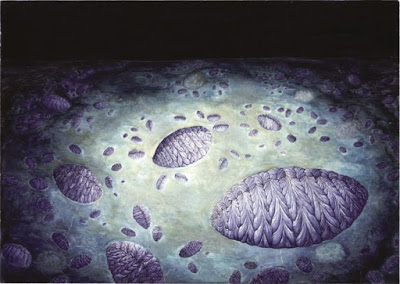
Researchers led by the University of Cambridge have found the earliest example of reproduction in a complex organism. Their new study has found that some organisms known as rangeomorphs, which lived 565 million years ago, reproduced by taking a joint approach: they first sent out an ‘advance party’ to settle in a new area, followed by rapid colonisation of the new neighbourhood. The results, reported today in the journal Nature, could aid in revealing the origins of our modern marine environment.
Using statistical techniques to assess the distribution of populations of a type of rangeomorph called Fractofusus, the researchers observed that larger ‘grandparent’ rangeomorphs were randomly distributed in their environment, and were surrounded by distinct patterns of smaller ‘parents’ and ‘children’. These patterns strongly resemble the biological clustering observed in modern plants, and suggest a dual mode of reproduction: the ‘grandparents’ being the product of ejected waterborne propagules, while the ‘parents’ and ‘children’ grew from ‘runners’ sent out by the older generation, like strawberry plants.
Rangeomorphs were some of the earliest complex organisms on Earth, and have been considered to be some of the first animals — although it’s difficult for scientists to be entirely sure. They thrived in the oceans during the late Ediacaran period, between 580 and 541 million years ago, and could reach up to two metres in length, although most were around ten centimetres. Looking like trees or ferns, they did not appear to have mouths, organs, or means of moving, and probably absorbed nutrients from the water around them.
Like many of the life forms during the Ediacaran, rangeomorphs mysteriously disappeared at the start of the Cambrian period, which began about 540 million years ago, so it has been difficult to link rangeomorphs to any modern organisms, or to figure out how they lived, what they ate and how they reproduced.
“Rangeomorphs don’t look like anything else in the fossil record, which is why they’re such a mystery,” said Dr Emily Mitchell, a postdoctoral researcher in Cambridge’s Department of Earth Sciences, and the paper’s lead author. “But we’ve developed a whole new way of looking at them, which has helped us understand them a lot better — most interestingly, how they reproduced.”
Mitchell and her colleagues used high-resolution GPS, spatial statistics and modelling to examine fossils of Fractofusus, in order to determine how they reproduced. The fossils are from south-eastern Newfoundland in Canada, which is one of the world’s richest sources of fossils from the Ediacaran period. Since rangeomorphs were immobile, it is possible to find entire ecosystems preserved exactly where they lived, making them extremely suitable for study via spatial techniques.
The ‘generational’ clustering patterns the researchers observed fit closely to a model known as a nested double Thomas cluster model, of the type seen in modern plants. These patterns suggest rapid, asexual reproduction through the use of stolons or runners. At the same time, the random distribution of larger ‘grandparent’ Fractofusus specimens suggests that they were the result of waterborne propagules, which could have been either sexual or asexual in nature.
“Reproduction in this way made rangeomorphs highly successful, since they could both colonise new areas and rapidly spread once they got there,” said Mitchell. “The capacity of these organisms to switch between two distinct modes of reproduction shows just how sophisticated their underlying biology was, which is remarkable at a point in time when most other forms of life were incredibly simple.”
The use of this type of spatial analysis to reconstruct Ediacaran organism biology is only in its infancy, and the researchers intend to extend their approach to further understand how these strange organisms interacted with each other and their environment.
The research was funded by the Natural Environment Research Council.
Reference:
Emily G. Mitchell, Charlotte G. Kenchington, Alexander G. Liu, Jack J. Matthews, Nicholas J. Butterfield. Reconstructing the reproductive mode of an Ediacaran macro-organism. Nature, 2015; DOI: 10.1038/nature14646
Note: The above post is reprinted from materials provided by University of Cambridge. The original story is licensed under a Creative Commons Licence.










